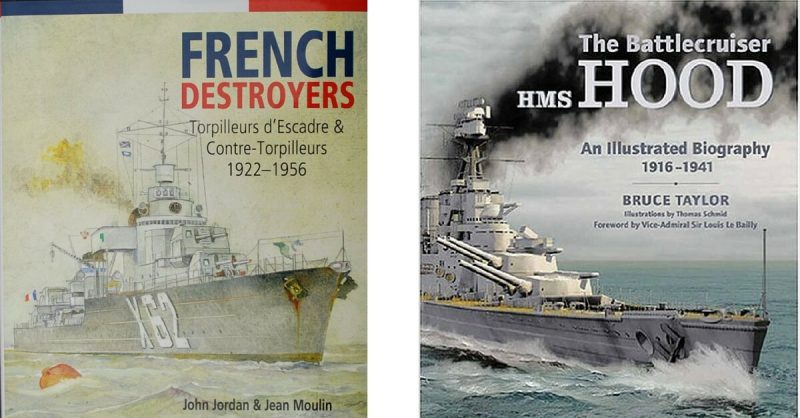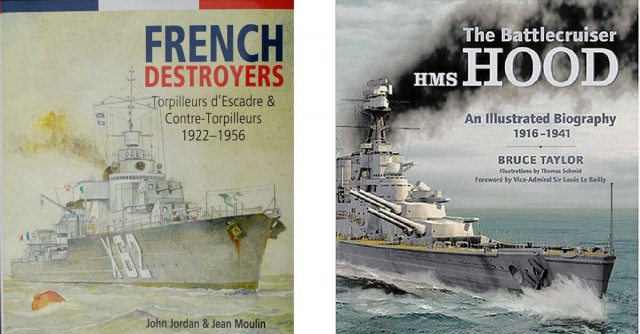Seaforth books always bring a smile to my face. I like the layout and the use of archive photography and their books have been some of my favourites in recent years. That tradition continues with these two first class books on very different warships.
In the first, John Jordan and Jean Moulin take us through the history of French destroyers from the 1920s until the 1950s. The period represents one of immense highs and lows for France and we see the fluctuations in fortunes and how they impacted on warship development and production in a country with a long naval tradition. If you look at French warships today they have something singularly Gallic about them setting them apart from so many other vessels even in an age when uniformity seems so prevalent. The destroyers of the period covered here have that hint of something aesthetic about them which certainly separates them from what was happening across the English Channel. Designs for super-destroyers, the Contre-Torpilleurs , were innovative and exciting. These ships look fantastic.
As with all these things I admit to having no in depth technical knowledge of warships. But, I like reading about them and am a huge fan of maritime archive photography and technical drawings. There is more than enough here to keep me entertained. The authors take us through all the classes built in their chosen period and look at camouflage and markings. The remainder of the book looks at the service histories of the destroyer fleet and it all adds up to make a genuinely fascinating and educational package. I love it.
If you really want to pull on heart strings, though, then the life and tragic loss of HMS Hood is something else altogether. Bruce Taylor has produced a wonderful illustrated biography of that most emblematic of vessels that perhaps more than any other signalled the end of the surety that Britannia ruled the waves. The loss of the Hood in the Denmark Strait in 1941 was a catastrophe for the Royal Navy and the British Empire in that cruel year when so many things went terribly wrong during World War II. Her final moments when she blew to smithereens with the loss of all but three of her ship’s company are etched on the Royal Navy. But, however dramatic and terrible the battle with the Bismarck was, the life of Hood was so much greater and vivid and telling this story is really important.
Fixating on events in May 1941 detracts from her importance between the wars and just how much she meant to Britain. Hood toured the world flying the flag and acted as a calling card of British sea power. As ships go, she was immense, both all-powerful and beautiful. She was one of a kind and it is unlikely another Royal Navy ship will ever carry the name. Her fame around the world in the days before modern telecoms was huge and in recording her loss Ludovic Kennedy alluded to the world cruises she undertook and how her arrival in any port was an event. Even now it is possible to smile at the days when the great capital ships of the Royal Navy would tour the coastal towns of Britain to show the people their navy. Here in sunny Southend Hood and other majestic ships would line up at the end of the pier lit up in all their glory and the photographs of the period are so impressive it is hard to believe that era is just a fading memory. Hood was special and her significance even crept in to Star Trek where a ship was named after her.
The fact is we know it was all a chimera. The Royal Navy, hampered by a miserly Treasury and political delusions over arms limitations did not expand or develop anything like as much as it needed to by the summer of 1939. It was also a victim of it’s own delusions where the strong belief of an inherent infallibility was about to be smashed by the Germans and Japanese. Hood represents much of this.
Mr Taylor’s lovely book takes us into the heart of the ship and shows so much of that life before the horrible death. His book really works for me because it illustrates the success of Hood in so many respects and the author nails her importance as a cypher of a lost Britain and all that she represents. Only recently one of her ship’s bells was recovered from the wreck miles down in the Atlantic Ocean. This feat does something to echo the immense effort to produce and operate a ship as amazing as HMS Hood and it is fitting that something tangible from her can be preserved.
Reviewed by Mark Barnes for War History Online.

FRENCH DESTROYERS
Torpilleurs d’Escadre & Contre-Torpilleurs 1922-1956
By John Jordan & Jean Moulin
Seaforth Publishing
ISBN: 978 1 84832 198 4

THE BATTLECRUISER HMS HOOD
An Illustrated Biography 1916-1941
By Bruce Taylor
Seaforth Publishing
ISBN: 978 1 84832 248 6

